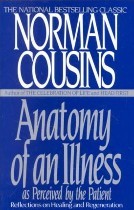 Norman Cousins •
Norman Cousins •
Anatomy of an Illness •
Credit Norman Cousins with paving the way for widespread acceptance of alternative healing practices. Fifty years ago he engineered his own recovery from a debilitating, painful illness that medical specialists considered incurable.
Working closely with his personal physician, Cousins arranged to be transferred from a hospital to a hotel room, where he watched Marx Brothers movies while ascorbic acid dripped into his veins through an IV tube. The belly laughter helped him sleep without drugs; the concentrated doses of vitamin C reduced his sedimentation levels; and within days he had improved dramatically.
But the story doesn’t end there. Cousins, an editor by trade and curious by nature, did extensive research into the nature of healing, the placebo (“the doctor who resides within”), and the link between creativity and longevity, as exemplified by Pablo Casals and Albert Schweitzer. One particularly eye-opening chapter deals with leprosy and the prevailing myth that the body parts of lepers “fall off” as an inevitable consequence of the disease. The real reason lepers lose fingers, toes, even noses is something quite different—and wholly preventable.
Throughout the book Cousins emphasizes the partnership between physician and patient. While he supports the use of advanced technology, he feels that too often it has replaced the more human aspects of treatment. His own experience convinced him that “nothing a hospital could provide in the way of technological marvels was as helpful as an atmosphere of compassion.”
The concepts Cousins puts forth seem less radical today than they did when the book was published in 1979—mainly because he has been proved right on so many points. This is as good an introduction as you’ll find to holistic health, written by a courageous man who defied conventional medicine to listen to the wisdom of his body.







Your email address will not be published.